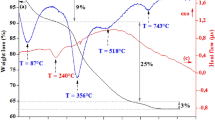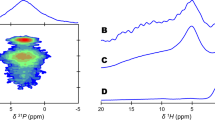Abstract
Amorphous calcium phosphate was found to be a major mineral component of skeletal tissue by X-ray diffraction techniques. This non-crystalline bone mineral phase can be converted into crystalline apatitein vitro upon exposure to water for a prolonged period of time. The amorphous calcium phosphate content of whole rat femur, tibia-fibula and calvarium decreases as the crystalline apatite content of these bones increases with advancing age. In addition, hypophysectomized whole rat femora contain more amorphous bone mineral than do normal controls. No significant differences in amorphous/crystalline bone mineral composition exist between control and denervated whole rat femora during disuse osteoporosis. However, rachitic chick bone contains more amorphous calcium phosphate than does normal bone tissue, regardless of the manner in which the disease state is reached. Moreover, alterations in chick bone lipid and mucopolysaccharide content coincide with corresponding alterations in the amorphous/crystalline mineral content of the tissue. It is suggested that amorphous calcium phosphate is the first mineral deposited during the calcification process and that the amorphous bone mineral fraction can act as a metabolically active, metastable precursor of crystalline bone apatite. It is further suggested that the amorphous calcium phosphate fraction of bone mineral may also exist in a stabilized form.
Résumé
L'analyse de diffraction par rayons X a montré que le phosphate de calcium amorphe est un des principaux constituants du squelette. Cette phase solide, non cristallisée de l'os peut se transformer en apatite cristalline in vitro après avoir été en contact avec de l'eau pendant une période suffisamment longue. Chez le rat, la teneur en phosphate de calcium amorphe des fémurs, tibias, péronés et des calottes crâniennes décroît, alors que la teneur en apatite cristalline de ces os croît, avec l'âge. De plus. les fémurs de rats hypophysectomisés contiennent une plus grande proportion de minéral osseux sous forme amorphe que ceux de témoins normaux. En ce qui concerne la proportion de minéral amorphe et cristallin dans l'ostéoporose d'immobilisation, on n'observe pas de différence significative entre des fémurs dénervés et des os témoins. Cependant, l'os de poulets rachitiques contient plus de phosphate de calcium amorphe que le tissu osseux de poulets sains, quelle que soit la manière dont on a provoqué le rachitisme. De plus, des modification de la teneur de l'os de poulet en lipides et en mucopolysaccharides correspondent à des modifications du rapport entre minéral amorphe et cristallin de l'os. Nous suggérons que le phosphate de calcium amorphe est la première forme minérale déposée au cours de la calcification et que la fraction amorphe est un précurseur métaboliquement actif et métastable de l'apatite cristalline: Il semble d'autre part que le phosphate de calcium amorphe peut également exister sous une forme stable.
Zusammenfassung
Das amorphe Calciumphosphat wurde mittels Röntgenstrahlendiffraktionsmethoden als eine der wichtigsten Komponenten des Knochengewebes erkannt. Dieser nicht kristallisierte Teil des Knochenminerals kann in vitro durch Wassereinwirkung während längerer Zeit in kristallines Apatit umgewandelt werden. Bei Ratten nimmt der Gehalt an amorphem Calciumphosphat der ganzen Femora, Tibia, Fibula und Calvaria mit zunehmendem Alter ab, während der Gehalt an kristallinem Apatit steigt. Dazu enthalten die Femora von hypophysektomierten Ratten mehr amorphes Knochenmineral als die von normalen Tieren. Es besteht kein signifikanter Unterschied im relativen Gehalt von amorphem und kristallinem Knochenmineral zwischen Kontroll- und denervierten Rattenfemora bei Immobilisationsosteoporose. Jedoch enthalten Knochen von rachitischen Hühnern, ungeachtet auf welche Art die Krankheit hervorgerufen wurde, mehr amorphes Calciumphosphat als normales Knochengewebe. Ferner stimmen die Veränderungen des Lipids- und Mucopolysaccharidgehaltes der Hühnerknochen mit entsprechenden Veränderungen im Gehalt an amorphem und kristallinem Mineral des Gewebes überein. Es wird vorgeschlagen, daß amorphes Calciumphosphat das erste Mineral ist, welches während des Verkalkungsprozesses abgelagert wird, und daß dieser Anteil an amorphem Knochenmineral als ein metabolisch aktiver, metastabiler Vorgänger des kristallinen Knochenapatites wirken kann. Dieser amorphe Calciumphosphatanteil des Knochenminerals könnte auch in einer stabilen Form vorkommen.
Similar content being viewed by others
References
Alexander, L. E., andH. P. Klug: Basic aspects of x-ray absorption in quantitative diffraction analysis of powder mixtures. Analyt. Chem.20, 886–889 (1948).
Bachra, B. N., O. R. Trautz, andS. L. Simon: Precipitation of calcium carbonates and phosphates. I. Spontaneous precipitation of calcium carbonates and phosphates under physiological conditions. Arch. Biochem. Biophys.103, 124–138 (1963).
———: Precipitation of calcium carbonates and phosphates. III. The effect of magnesium and fluoride ions on the spontaneous precipitation of calcium carbonates and phosphates. Arch. oral Biol.10, 731–738 (1965).
Burley, R. W.: Transphosphorylation of adenosine di- and tri-phosphates in the presence of calcium phosphate precipitates. Nature (Lond.)208, 683–684 (1965).
Eanes, E. D.: Personal communication (1966).
—,I. H. Gillessen, andA. S. Posner: Intermediate states in the precipitation of hydroxyapatite. Nature (Lond.)208, 365–367 (1965).
—, andA. S. Posner: Kinetics and mechanism of conversion of non-crystalline calcium phosphate to crystalline hydroxyapatite. Trans. N. Y. Acad. Sci.28, 233–241 (1965).
Fitton-Jackson, S., andJ. T. Randall: In: Bone structure and metabolism (G. E. W. Wolstenholme andC. M. O'Connor, eds.); Fibrogenesis and the formation of matrix in developing bone, p. 47–64. London: J. & A. Churchill, Ltd. 1956.
Fleisch, H.: Role of nucleation and inhibition in calcification. Clin. Orthop.32, 170–180 (1964).
—,D. Schibler, J. Maerki, andI. Frossard: Inhibition of aortic calcification by means of pyrophosphate and polyphosphates. Nature (Lond.)208, 1300–1301 (1965).
Greenawalt, J. W., C. S. Rossi, andA. L. Lehninger: Effect of active accumulation of calcium and phosphate ions on the structure of rat liver mitochondria. J. Cell Biol.21, 21–38 (1964).
Harper, R. A., andA. S. Posner: Measurement of non-crystalline calcium phosphate in bone mineral. Proc. Soc. exp. Biol. (N.Y.)122, 137–142 (1966).
Höhling, H. J., H. Theman, andJ. Vahl: In: Third european symposium on calcified tissues (H. Fleisch, H. J. J. Blackwood, andM. Owen, eds.); Collagen and apatite in hard tissues and pathological formations from a crystal chemical point of view, p. 146–151. Berlin-Heidelberg-New York: Springer 1966.
Kharmosh, O., andP. D. Saville: The effect of motor denervation on muscle and bone in the rabbit's hind limb. Acta orthop. scand.36, 361–370 (1965).
Klug, H. G., andL. E. Alexander: X-ray diffraction procedures, p. 92. New York: J. P. Wiley & Sons 1954.
Leach, R. M. Jr., andA. M. Muenster: Studies on the role of manganese in bone formation. I. Effect upon the mucopolysaccharide content of chick bone. J. Nutr.78, 51–57 (1962).
—, andM. C. Nesheim: Nutritional, genetic and morphological studies of an abnormal cartilage formation in young chicks. J. Nutr.86, 236–244 (1965).
Molnar, Z.: Development of the parietal bone of young mice. I. Crystals of bone mineral in frozen-dried preparations. J. Ultrastruct. Res.3, 39–45 (1959).
Peachey, L. D.: Electron microscopic observations on the accumulation of divalent cations in intramitochondrial granules. J. Cell Biol.20, 95–112 (1964).
Posner, A. S., A. D. Eanes, R. A. Harper, andI. Zipkin: X-ray diffraction analysis of the effect of fluoride on human bone apatite. Arch. oral Biol.8, 549–570 (1963).
—,R. A. Harper, S. A. Muller, andJ. Menczel: Age changes in the crystal chemistry of bone apatite. Ann. N.Y. Acad. Sci.131, 737–742 (1965).
Prins, J. A.: In: Physics of non-crystalline solids (J. A. Prins, ed.); Structure of non-crystalline solids, p. 1–11. New York: Interscience 1965.
Robinson, R. A., andM. L. Watson: Crystal-collagen relationships in bone as observed in the electron microscope. III. Crystals and collagen morphology as a function of age. Ann. N.Y. Acad. Sci.60, 596–628 (1955).
Termine, J. D.: Amorphous calcium phosphate: the second mineral of bone. Ph. D. Thesis, Cornell University 1966.
—, andA. S. Posner: Infrared analysis of rat bone: age dependency of amorphous and crystalline mineral fractions. Science153, 1523–1525 (1967).
Termine, J. D., R. E. Wuthier, andA. S. Posner: Nature of the mineral phase during endochondral and periosteal bone formation. In preparation (1966).
Watson, M. L., andR. A. Robinson: Collagen-crystal relationships in bone as seen in the electron microscope. II. Electron microscope study of basic calcium phosphate crystals. Amer. J. Anat.93, 25–60 (1953).
Author information
Authors and Affiliations
Additional information
This work was supported in part by PHS Grant DE-10945 from the National Institute of Dental Research, U.S.A. Publication No. 24 from the Laboratory of Ultrastructural Biochemistry.
Rights and permissions
About this article
Cite this article
Termine, J.D., Posner, A.S. Amorphous/crystalline interrelationships in bone mineral. Calc. Tis Res. 1, 8–23 (1967). https://doi.org/10.1007/BF02008070
Received:
Issue Date:
DOI: https://doi.org/10.1007/BF02008070




